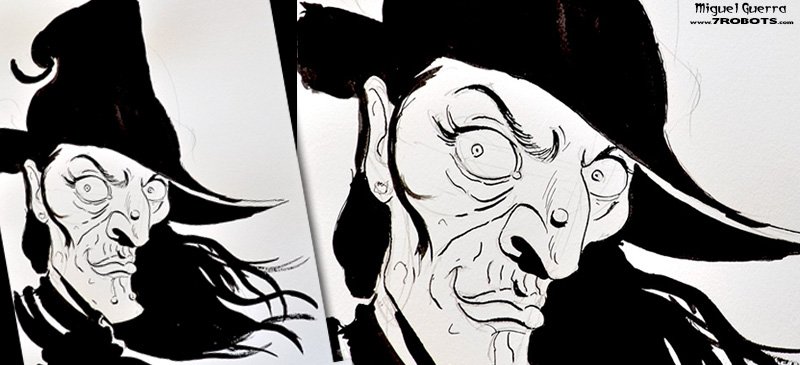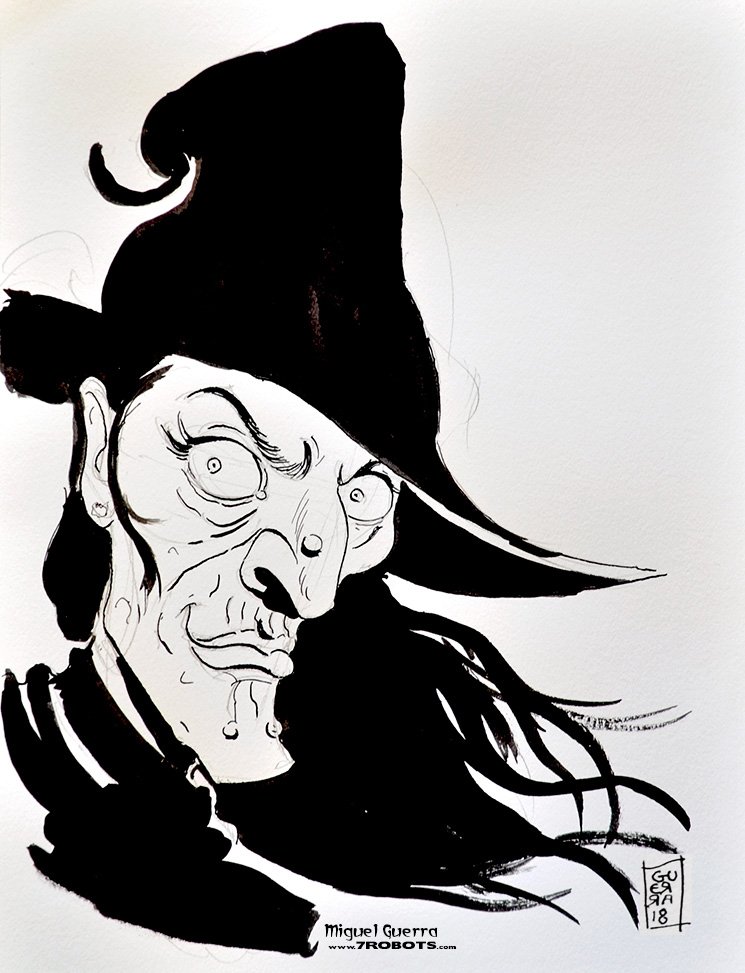
Horror Ink Sketches
As part of our horror countdown we’re posting one new ink sketch every day until…well, until Miguel stops drawing more. Miguel was caught up in a creative frenzy and drew a ton of Horror illustrations. Who can blame him? Every time I arrived home, there were more black and white sketches all over the place. So, we’re posting all of his horror sketches!
★To see all of the Horror Ink Sketches, click here.
The Witch
“Images of witches have appeared in various forms throughout history—from evil, wart-nosed women huddling over a cauldron of boiling liquid to hag-faced, cackling beings riding through the sky on brooms wearing pointy hats. In pop culture, witches have been a benevolent, nose-twitching, suburban housewife, an awkward teenager learning to control her powers and a trio of charmed sisters battling the forces of evil. The real history of witches, however, is dark and, often for the witches, deadly.”
The Origin of Witches
“Early witches were people who practiced witchcraft—they used magic spells and called upon spirits for help or to bring about change. Most witches were thought to be pagans doing the Devil’s work. Many, however, were simply natural healers or so-called “wise women” whose choice of profession was misunderstood.
It’s unclear exactly when witches came on the historical scene, but one of the earliest records of a witch is in the Bible in the book of 1 Samuel, thought be written between 931 B.C. and 721 B.C. It tells the story of when King Saul sought the Witch of Endor to summon the dead prophet Samuel’s spirit to help him defeat the Philistine army…” [click here to read more]
Malleus Maleficarum
Witch hysteria really took hold in Europe during the mid-1400s, when many accused witches confessed, often under torture, to a variety of wicked behaviors. Within a century, witch hunts were common and most of the accused were executed by burning at the stake or hanging.
Between the years 1500 and 1660, up to 80,000 suspected witches were put to death in Europe. Around 80 percent of them were women thought to be in cahoots with the Devil and filled with lust. Germany had the highest witchcraft execution rate, while Ireland had the lowest.
The publication of Malleus Maleficarum—written by two well-respected German Dominicans in 1486—likely spurred witch mania to go viral. The book, known as the Hammer of Witches, was essentially a guide on how to identify, hunt and interrogate witches.
Malleus Maleficarum labeled witchcraft as heresy, and quickly became the authority for Protestants and Catholics trying to flush out witches living among them. For more than 100 years, the book sold more copies of any other book in Europe except the Bible.
Salem Witch Trials
As witch hysteria decreased in Europe, it grew in the New World. Probably the best-known witch trials took place in Salem, Massachusetts in 1692. The Salem witch trials began when two ill girls claimed to be witches and accused many of their neighbors of witchcraft. Ultimately, around 150 people were accused and 18 were put to death.
Massachusetts wasn’t the first of the 13 colonies to obsess about witches, though. In Windsor, Connecticut in 1647, Alse Young was the first person in America executed for witchcraft. Before Connecticut’s final witch trial took place in 1697, forty-six people were accused of witchcraft in that state and 11 put to death for the crime.”[click here to read more]
Pointing to Witchcraft: The Possible Origin of the Conical Witch’s Hat
“If one were to walk down a crowded street wearing a black conical hat, passersby would not question the wearer’s intention. Obviously, the wearer would be playing the role of a witch. Yet as obvious as the pointed hat is as a sign of witchcraft today, its origins as representing witchcraft is just as evidently difficult to trace. Conical hats have a long history in the fashions of the world; however, it was not until the pervasiveness of Christianity in the Middle Ages and medieval periods that the term “witchcraft” took on a such nefarious meaning, that a symbol of this role was necessary…
Pointed hats were also a sign of untrustworthy foreigners. For example, in ancient Greek texts and art works, any figure described or shown as wearing a soft, slightly pointed cap (also called a Phrygian hat) was considered a barbarian…
Even though witchcraft has been a belief throughout history (albeit in various forms), it gained its status as a negative force during the medieval and early modern period, when the Church damned it as Devil worship. It was used to explain heresy and the spread of diseases or failed crops. In the 15th century, there was even a manual created on how to properly engage in witch-hunting, and what signs to be aware of when attempting to recognize a witch.” [click here to read more]
The Witch by Miguel Guerra
Related Links:
★ Horror Ink Sketch series by Miguel Guerra
★ Pointing to Witchcraft: The Possible Origin of the Conical Witch’s Hat
